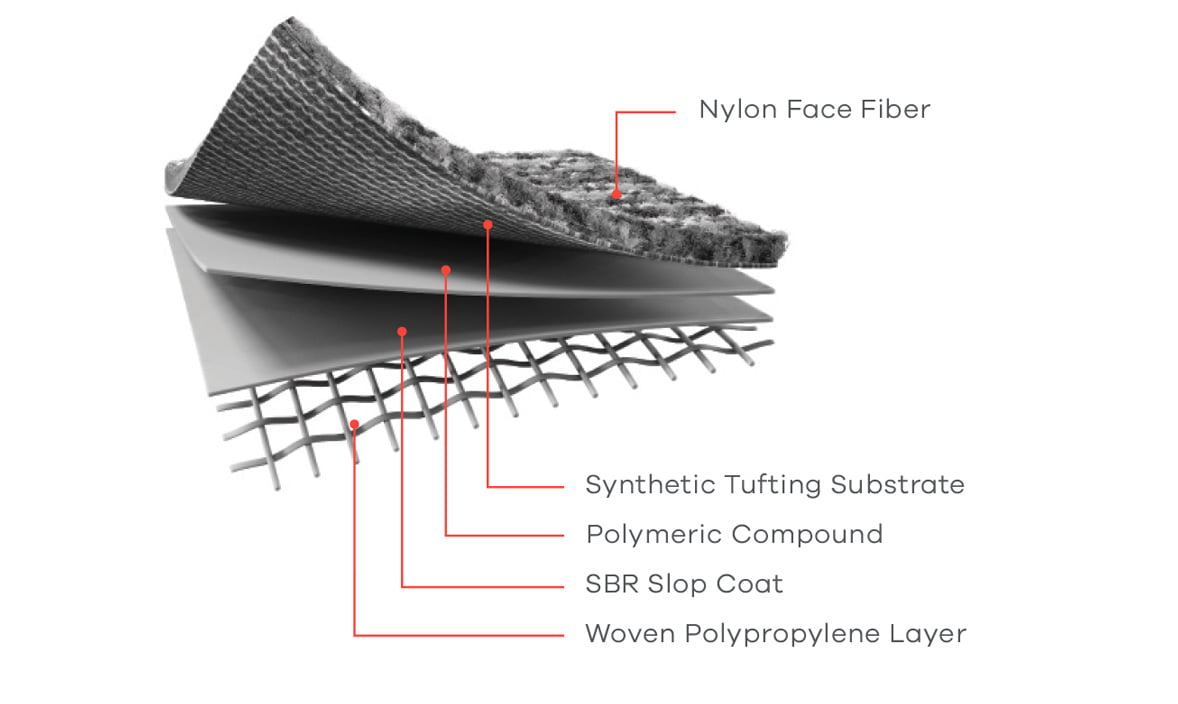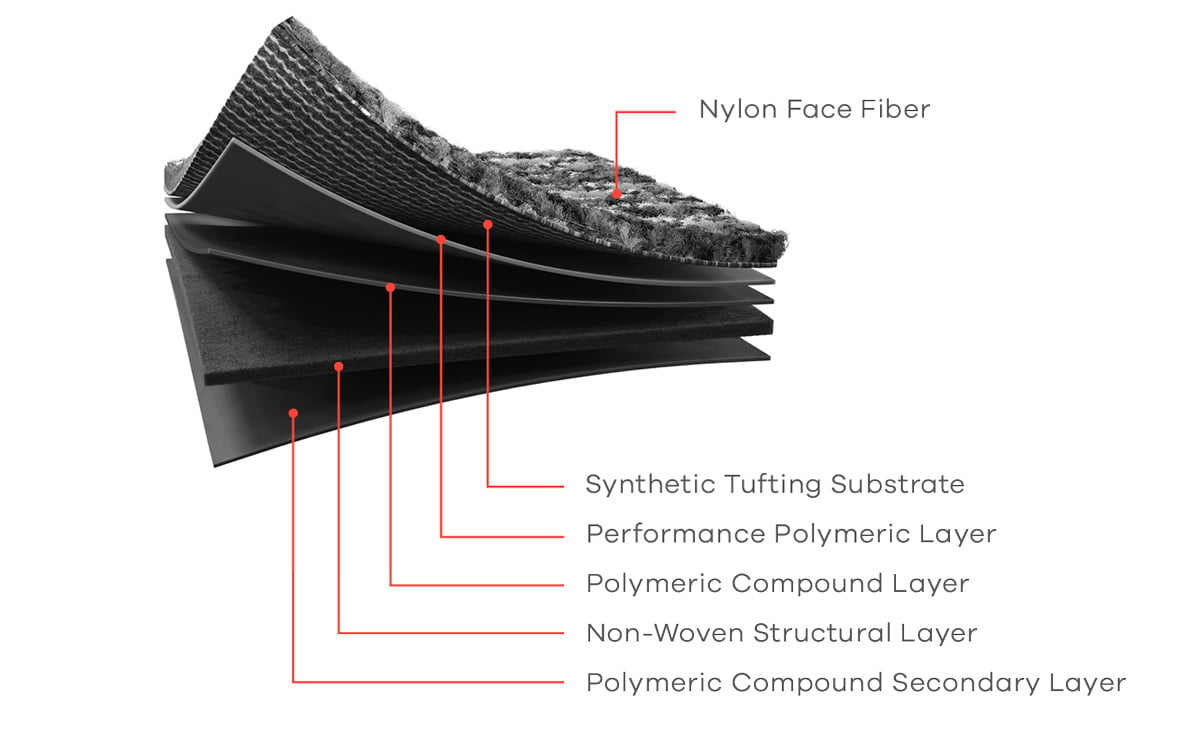The past 15 to 20 years has seen a number of innovations leading to the development of high performance, durable and efficient carpet backing systems. To achieve different goals in performance and sustainability, carpet backings can be made from different types of material with various characteristics.
There are many options to consider when specifying commercial carpet, and it’s important to know what to look for when it comes to the backing. Whether you’re specifying carpet for the first time, or you’re investigating why your carpet is failing, we've got you covered. It’s the reason we created this blog in the first place, to answer your questions.
At Mannington Commercial, we’ve spent more than 100 years designing and perfecting flooring to exceed your performance expectations, and that includes carpet backing. In this article, we’ll dive into carpet backing chemistries, explain how various carpet backing systems are formulated and look at the three major carpet backing types:
- First Major Carpet Backing Type: Latex
- Second Major Carpet Backing Type: Polyurethane
- Third Major Carpet Backing Type: Thermoplastics
The Backing Process
Backing carpet includes applying an adhesive coating to the primary backing and in most cases then joining the primary backing with a secondary backing. Sometimes the secondary backing is a single layer, but it is more common for the secondary backing to be multiple layers. There are several common techniques for how the primary and secondary backings are applied.
One technique is a puddling process where a viscous polymer is added onto the material. Another technique is to extrude a sheet onto the material. A third technique is to attach a finished backing.
After the backing is applied and the primary and secondary backings are joined, the carpet goes through the drying oven, where moisture is removed from the adhesive that was applied during the backing process. For tip-sheared carpets, shearing is completed after drying and before the carpet manufacturing process is complete.
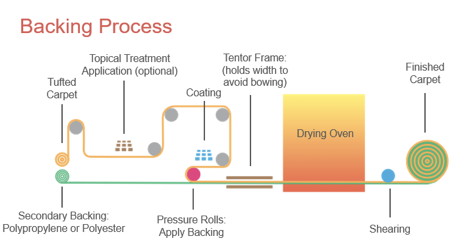
Why Is Carpet Backed?
The primary reason carpet is backed is to lock the stitches into the primary backing, which increases the tuft bind. Tuft bind is the force required to pull up the tuft from the carpet.
A high tuft bind means edge ravel is less likely as well as zippering, sprouts, and other surface irregularities. Backing carpet also increases durability, improves appearance retention, adds dimensional stability, makes it easier to install, and may provide a moisture barrier.
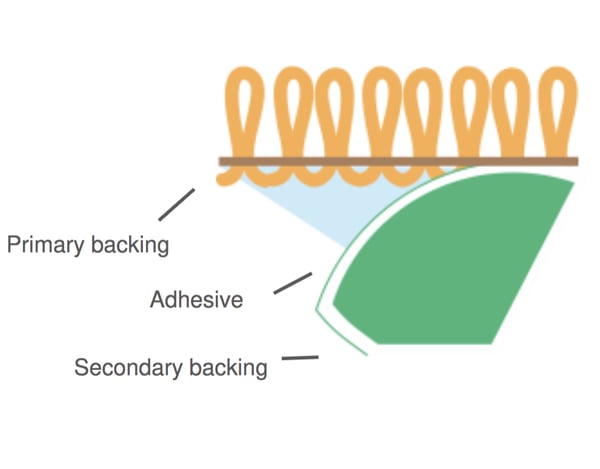
Carpet Backing Chemistries
There are basically three categories of backing systems used by all carpet manufacturers. They can be divided into latex, polyurethanes, and thermoplastics.
There is not one perfect backing system for every commercial carpet installation. Instead, each backing system has benefits and a few challenges. Let’s look a little closer at each of the categories.
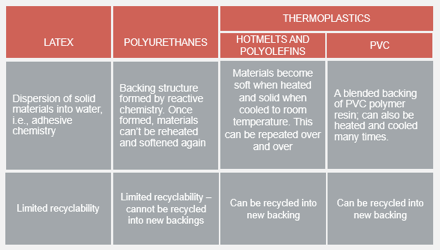
First Major Carpet Backing Type: Latex
Latex is the first major category of carpet backing systems. The latex category consists of styrene butadiene rubber (SBR), vinyl acetate ethylene (VAE) and polyurethane dispersion (PUD). Latex is a dispersion of solid material into water (in other words: adhesive chemistry), and it has limited recyclability.
Latex in carpet backing is actually synthetic latex. Why use synthetic latex and not natural latex?
Advantages of Latex-Backed Carpet
Not only is synthetic latex incredibly versatile, it’s also superior to its natural counterpart in most applications. Perhaps the best attribute of emulsion polymers is that when added to a formula, they can achieve a variety of goals for improving products: increasing adhesion, water resistance, durability, flexibility, strength and operating as extenders of natural rubber, as needed. Specifically, SBR (styrene butadiene rubber) can provide greater strength than other types of latex, has good flexibility and provides excellent water resistance.
Latex is a water-based solution and an industry standard for broadloom carpet. Every manufacturer makes this type backing because latex is cost-effective, has excellent pattern-match characteristics due to its ability to stretch, is installer-friendly, has good tuft bind and has good edge-ravel strength.
Disadvantages of Latex-Backed Carpet
SBR latex is an industry standard for broadloom and often used as a precoat for carpet tile; however, it can deteriorate with age or when it repeatedly comes in contact with water. It absorbs moisture, contains no recycled content, has few warranties and is subject to delamination (a condition when the secondary backing is separated from the primary backing). It is important to note that latex will not pass a moisture impact test.
Second Major Carpet Backing Type: Polyurethane
The second major category of carpet backing chemistries is polyurethanes, which consists of polyurethanes and urethanes. They are backing structures formed by reactive chemistry. Once formed, polyurethanes cannot be reheated and softened again. Like latex, polyurethanes also have limited recyclability and cannot be recycled into new backings.
Advantages of Polyurethane-Backed Carpet
Polyurethanes have a distinct molecular structure that creates an extremely strong material which holds up to the toughest abuse. It is also ideal for forming a polymeric bond between a primary backing and a secondary backing, boosting the carpet performance over the years.
Finally, because it has such strong adhesion properties, the yarn of the carpet remains tightly woven, increasing the tuft bind, or the amount of force it takes to lift a carpet fiber. It is affordable, provides good moisture protection and has excellent edge-ravel protection. Most of the time polyurethane backings are cushions so they provide comfort underfoot.
Disadvantages of Polyurethane-Backed Carpet
Polyurethane backings offer good warranties because of their durable nature; however, they may be more costly to install than other backing systems because of the time involved. Additionally, polyurethane backings are subject to possible delamination in modular backings, have limited recyclability and seam welding is not possible. Without welded seams, you cannot get a true wall-to-wall moisture barrier.
Third Major Carpet Backing Type: Thermoplastics
The third major class of backing chemistries is thermoplastics. There are three different types of thermoplastics, each with different characteristics. All thermoplastics can be heated up and then cooled many times and have similar performance features. They all have dimensional stability and have excellent delamination and edge ravel strength. Additionally, some provide an impervious moisture barrier.
The thermoplastics category can be split into 2 subgroups. Group 1 is hotmelts and polyolefins. These are materials that become soft when heated and solid when cooled to room temperature. This process can be repeated over and over again, meaning they can be recycled into new backings. Thermoplastics group 2 is PVC, or polyvinyl chloride, which is a blended backing of PVC polymer and resin. PVC can also be heated and cooled many times, so it can be recycled into new backings.
Types of Thermoplastic-Backed Carpet
Thermoplastic backings also use less material, which can help conserve resources and energy, and result in a lighter weight carpeting, which would in turn require less cost and fuel for shipping and allow for easier installation. This includes ethylene vinyl acetate compounded with resins, polyvinyl butyrate, polyethylene, and polyvinyl chloride. The nature of thermoplastic backings is that they are recyclable.
Hotmelt Backing Systems
One main subcategory of thermoplastics is hotmelt backing systems. These are not as prevalent as they were 15-20 years ago. With regard to broadloom, hotmelts have a higher tuft bind than latex and traditionally have very good warranties, making them better than latex in those categories.
However, they are more difficult to install and costlier than latex. They can become brittle in cold climates. While the seams can be sealed, they cannot be chemically welded, meaning that hotmelts do not provide an impervious moisture barrier.
Polyolefins
Another main subcategory of thermoplastics is polyolefins, which utilize an aqueous precoat system. While they are less sensitive to floor preparation or residues of old adhesive material, the thinness of this backing system may result in visible floor imperfections telescoping through the fibers. They are sensitive to temperature variations, and the seams cannot be chemically welded. Also, polyolefins have a limited track record since they are newer than other backing systems.
PVC
The third main subcategory of thermoplastics is polyvinyl chloride (PVC). PVC has dimensional stability and no delamination or edge ravel. PVC can be chemically welded to itself or other vinyl such as sheet vinyl. Chemically welding PVC to other vinyl flooring means you do not need to use a transition strip.
Not only does this provide an impervious moisture barrier, it also enhances the aesthetics of the installation. PVC can be used as a precoat in place of latex which results in a very high tuft bind as well as true wick-back stain prevention. PVC is non-aqueous so if there is a spill on the carpet, the liquid never gets beyond the fiber layer. PVC is a longtime industry standard and has a long life cycle. However, for broadloom applications, PVC is heavier and more expensive than latex.
The Ins and Outs Of Carpet Backing
In the world of specifying, there are many carpet backings options to consider and choose from. By comparing some of the larger categories such as latex, polyurethane and thermoplastic, we hope you gain a better understanding of how they are formulated and how they can impact your project success. We want to provide you with all the necessary information you need to make the best decision for your project.
At Mannington, we have a lot of people who know commercial and residential flooring like the back of their hand, and we are working to pull that information out of our experts and get it to you here in blog article form. Our goal is to bring you expert information that will help you break down some of the complexities of flooring materials and ultimately guide you to making the best and most informed choice for your projects.
Related: How to Choose a Commercial Carpet Backing System
Interested in learning more about how to commercial carpet backing systems?
We have an accredited CEU your local sales representative would be happy to present.
Would you like to keep reading about this topic? We've got an eBook for you!

